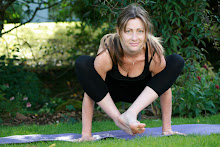Hi Everyone
Good to see you all in class last week, particularly those of you who were new. Well done, especially those who did the ashtanga session at Cairns on Monday. It's quite a tough session for the beginner, you did fantastically and I hope to see you all again next week.
For those of you who might be interested in trying some meditation to accompany your yoga practice I have pasted below an article by the renowned American yoga teacher Shiva Rea.
This method is one I have used myself which I found particularly useful when I first started meditating. Meditating takes a lot of patience and trial and error, but the rewards are worth it. So why not give the method described below a go and see how you get on. Be warned you might feel a bit daft the first couple of times you do it, don't let this put you off, that feeling goes when you get in to it.
Good luck
Jo x
A Higher Hum: Breath and Mantra Meditation
The following meditation is based upon the mantra "so hum," ("I am that") used within the traditions of Tantra and Vedanta.
By Shiva Rea
Mantra, the chanting of sacred words or sounds, is a central part of yogic meditation. Mantra comes from the combination of two syllables: "man," meaning "to reflect" or "be aware," and "tra," meaning "tool for" or "agent of." A mantra is a tool for reflection and the cultivation of awareness, and is used for both concentration and contemplation on the Source.
Within yoga, mantras are based upon sounds that reflect the energy of our divine nature. Om is considered to be the universal, consummate mantra. The following meditation is based upon the mantra "so hum," ("I am that") used within the traditions of Tantra and Vedanta. Since "so hum" also indicates the sound of the breath, it is a mantra that repeats itself effortlessly.
Find a comfortable posture for meditation (seated on a cushion or blanket, in a chair or against a wall). Place your palms facing up in jnana mudra (forefinger and thumb touching) with your palms facing up to open your awareness or facing down to calm the mind. Scan your body and relax any tension. Let your spine rise from the ground of the pelvis. Draw your chin slightly down and let the back of your neck lengthen.
Bring your attention to the tidal rhythm of your breath, feeling the rise and fall of your inhalation and exhalation. As your focus settles on your breath, begin to employ the simple mantra "so hum." As you inhale, say "so" silently to yourself, and as you exhale say "hum." Keep your focus on the sensation of your breath while silently repeating the sacred syllables, "so hum." As you drink your inhalation, gently drawing your breath along the base of your throat, listen for the sound of "so." As you exhale, listen for the sound of "hum" as your breath is amplified in the throat.
Let your mind become absorbed in the sound of so hum-in your internal chanting and your actual breath. As if you were watching the waves of the ocean, let your mind be naturally drawn into presence and stillness—no place to go, nothing to do, so hum, so hum. If a thought (vritti) arises, come back to the mantra so hum.
In the beginning, it may be helpful to set an external timer for 10, 20, or 30 minutes so you are not distracted. When you are finished, bring your hands together in anjali mudra (prayer position) and close with a moment of gratitude, reflection, or prayer to soak up the energy of your meditation into your being and life.
Cameo Blogger
14 years ago






No comments:
Post a Comment